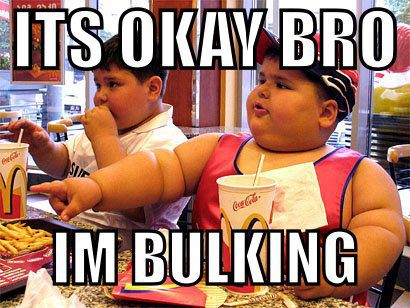|
Statistics show half of all men aged 16 to 30 and about 1 in 4 women have in the past or are currently using a bulk and cut dieting approach to gain as much muscle and get as lean as possible. The idea is you train like a savage, eat like a horse, and pack on slabs of muscle during your bulk then jump into a calorie deficit via nutrition and training adjustments to get lean and peeled like a ripe banana through a cut phase, rinse and repeat. The ultimate goal is to continually add muscle then shed fat, over and over again, to get as big and lean as possible. Unfortunately, bulk and cut dieting is NOT all it’s cracked up to be. And the number of people engaging in and supporting this approach across social and other media outlets are actually doing more harm than good to their health and the health of other workout warriors than not. Let me explain. As the popularity of bodybuilding proliferated in the 60’s, bulking and cutting rose to the top as the BEST way to get muscular and lean. Today, as referenced in the above study published last year in 2022, it’s still the most popular approach. And you can walk into and talk with just about any gym goer at your local Planet Fitness, Crunch, LAFitness, or other neighborhood globo-gym and see for yourself. During a bulking phase, you consume a calorie surplus to enter an anabolic state so your body is in a position to build muscle tissue. With that, because bulking often encourages eating just about anything you can get your hands on, your fat mass inevitably increases, which is why the cutting phase follows. This involves eating at a calorie deficit to create a catabolic state in the body, ultimately leading to weight loss. That’s the gist. In most circles, bulking phases last around 4-6 weeks and cutting phases 6-8 weeks. Sounds simple and glorious, right? In theory, heck yeah! However, more and more modern research shows bulking and cutting can cause some real, lasting problems, particularly if your overall goals are health, longevity and performance. If you want to feel good, have loads of energy, be active and engage in hobbies for a long time, maintain a healthy relationship with food, manage stress, stay lean as you age, and have the vitality to play with your kids and grandkids then this is NOT the best approach. TLDR: Bulking and cutting has received a lot of hype recently, BUT more and more studies are showing this method of getting swole can cause serious long-term problems. Tread carefully, gym lords and ladies. Let’s peek at some of the more recent studies, lay out the bad stuff we’re seeing from this overrated approach, and finish by looking at an alternative solution (the one I use with all of my clients). Let’s go! The serious risksThe journal referenced in the opening paragraph, Eating and Weight Disorders - Studies on Anorexia, Bulimia and Obesity, showed the “engagement in bulk and cut cycles was associated with stronger drive for muscularity across the sample, and more severe eating disorder and muscle dysmorphia psychopathology among men and women.” Simply, folks who engaged in bulking and cutting were more likely to have an eating disorder or were at higher risk for developing disordered eating down the line. This is no bueno. In my experience coaching hundreds of clients, working back from an eating disorder is a long and challenging road and can have serious ramifications on health, fitness and performance. The bulk and cut diet pushes many recreational athletes and exercisers down a frightening path, not to mention the other serious physical and performance-related impacts I’ve outlined below. increased fat gain, decreased muscle gainPhysically, bulking increases your stores of fat, increases the number of fat cells in your body making it more challenging to lose weight in the future, and decreases your insulin sensitivity (your cells become less responsive to insulin, requiring more insulin to regulate blood sugar levels, often leading to elevated blood sugar levels) thus putting you at higher risk for cardiovascular disease, type 2 diabetes, certain types of cancer and other gnarly diseases. It doesn’t stop there: sub-optimal insulin sensitivity over longer periods of time also challenges your body’s ability to gain muscle (opposite of the goal of a bulk)! On the cut phase side, losing weight quickly (over 1 pound per week as most bulk and cut dieters aim for), both increases cortisol and decreases testosterone production in the body. Essentially, it causes a cascade of changes in the body, raising levels of stress and maiming our ability to maintain and grow healthy muscle tissue. fluctuations in performanceAs for performance, aerobic endurance and maximal oxygen uptake often suffer during bulking, while strength drops off during the cut phase. What’s more, injury risk increases dramatically as body mass fluctuates significantly, up during a bulk and down during a cut. Let’s summarize the bad so far for both bulking and cutting:Bulking
Cutting
Ultimately, the severe weight fluctuations from bulking and cutting that we often see celebrated on Instagram and across social-media-land are closely linked to an increased risk of poor health and metabolic syndrome. And despite its recognition and popularity around fitness circles everywhere, there’s very little evidence to support the bulk and cut approach as the best way to build muscle and lose fat. Taking it a step further and placing the physical risks aside, adjusting your nutrition and training to the degree required to perform a bulk and cut is HARD. It requires a lot of time, planning and effort to execute, let alone to do it successfully. To be honest, in my experience, folks often find themselves at the same weight and shape they were before they ever bulked and cut. Or they jump into a “dirty bulk” (mass gainer shakes, no limits, eating everything in sight), gain weight and are fighting forevermore to get lean again. You CAN get muscular, lean AND have a healthy relationship with your nutrition that supports your goals for health, fitness and performance over the long-term. The key is to establish nutrition habits you feel good about, can be consistent with, and that allow you to make progress in the gym, whether your primary goal is aesthetics, strength, athletic performance-based, or something else! As a performance and nutrition coach working with clients, my focus is to get them to this point at a slight caloric surplus that we can monitor together every 4-6 weeks without having to stress about MyFitnessPal, Whoop, or any other fitness tracker. I typically recommend the “Clean Gain” method for clients I work with! Again, the focus is promoting a healthy, long-term nutrition approach where clients see the results they want (weight loss, muscle gain, sports performance, etc) while avoiding the severe fluctuations in weight and consequent adverse effects we see with the popular bulk and cut approach. the clean gainHere’s how it works:
Now, there are many caveats to this advice. The most common answer to questions in health, fitness and performance is “it depends,” and I’d be wary of any coach, trainer or guru who speaks in absolutes. The bulk and cut diet has worked for some but that doesn’t mean it’s the only approach, and it’s certainly not the best one. Find a performance coach who can answer your questions in a way you can understand and who can help you find the best starting place and approach for your lifestyle. If you made it this far and my article resonated with you I want to gift you a complimentary resource that’ll help you get started on your Clean Gain journey! It’s my Sexy Shopping List and it’s FREE for you if you head over to my contact page and write me a quick message! This is a resource normally reserved for my private clients that you can keep on your fridge, throw in your purse or wallet, and take with you on your next visit to the grocery store. It lays out the categories, approved foods and healthy snacks I use with my clients. And it includes additional keys for success and shopping tips! Just tap the link HERE, input your name and email and I’ll have it sent to your inbox in no time!
Thank you for reading! Please share this with anyone you think it could help. And most importantly, LET ME KNOW if and when you’re going to jump on the Clean Gain train! I’d love to hear from you and offer guidance if I can. Always happy to help!
0 Comments
|
hit us up.©2023 EXPLORE PERFORMANCE.
All Rights Reserved. |
quick links. |
powered by. |





 RSS Feed
RSS Feed








